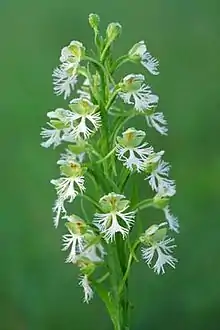Orchideae
Orchideae is a tribe of orchids in the subfamily Orchidoideae. It has been divided into two subtribes, Orchidinae and Habenariinae. The subtribe Orchidinae alone contains about 1,800 species.[1] However, although some phylogenetic studies have established the monophyly of the subtribes, the generic boundaries are unclear, with many genera as traditionally circumscribed being paraphyletic or even polyphyletic.[2] Species of genera such as Habenaria and Platanthera have been placed into both subtribes.[3] A 2017 molecular phylogenetic study found that both subtribes did form clades, but did not formally recognize Habenariinae, because of missing genera and uncertainty over generic boundaries.[1] The Asian species of Orchideae, in particular, have been subject to repeated changes of generic placement from 2012 onwards.[3][2][4][5][6][1]

| Orchideae | |
|---|---|
.jpg.webp) | |
| Flower of Orchis provincialis | |
| Scientific classification | |
| Kingdom: | Plantae |
| Clade: | Tracheophytes |
| Clade: | Angiosperms |
| Clade: | Monocots |
| Order: | Asparagales |
| Family: | Orchidaceae |
| Subfamily: | Orchidoideae |
| Tribe: | Orchideae (Dressler & Dodson) Verm. (1977) |
| Subtribes | |
| |
Genera
Genera included in a 2017 molecular phylogenetic study are listed below. As noted above, some generic boundaries remain uncertain; Habenaria in particular is not monophyletic.[1]
- Anacamptis
- Benthamia
- Bonatea
- Brachycorythis
- Chamorchis
- Cynorkis
- Dactylorhiza
- Diplomeris
- Galearis s.l. (including Aceratorchis, Amerorchis and Neolindleya)
- Gennaria
- Gymnadenia (including Nigritella)
- Habenaria (not monophyletic)
- Hemipilia (including a few species previously assigned to Amitostigma and Ponerorchis)
- Herminium
- Himantoglossum
- Hsenhsua
- Neotinea
- Ophrys
- Orchis s.s.
- Pecteilis
- Peristylus
- Physoceras
- Platanthera s.l.
- Ponerorchis s.l. (including Amitostigma and Neottianthe)
- Pseudorchis
- Satyrium
- Schizochilus
- Serapias
- Shizhenia
- Sirindhornia
- Stenoglottis
- Steveniella
- Traunsteinera
- Tsaiorchis
- Tylostigma
See also
References
- Jin, Wei-Tao; Schuiteman, André; Chase, Mark W.; Li, Jian-Wu; Chung, Shih-Wen; Hsu, Tian-Chuan & Jin, Xiao-Hua (2017), "Phylogenetics of subtribe Orchidinae s.l. (Orchidaceae; Orchidoideae) based on seven markers (plastid matK, psaB, rbcL, trnL-F, trnH-psba, and nuclear nrITS, Xdh): implications for generic delimitation", BMC Plant Biology, 17: 222, doi:10.1186/s12870-017-1160-x
- Jin, Wei-Tao; Jin, Xiao-Hua; Schuiteman, André; Li, De-Zhu; Xiang, Xiao-Guo; Huang, Wei-Chang; Li, Jian-Wu & Huang, Lu-Qi (2014), "Molecular systematics of subtribe Orchidinae and Asian taxa of Habenariinae (Orchideae, Orchidaceae) based on plastid matK, rbcL and nuclear ITS", Molecular Phylogenetics and Evolution, 77: 41–53, doi:10.1016/j.ympev.2014.04.004, PMID 24747003
- Jin, Xiao-Hua; Li, De-Zhu; Xiang, Xiao-Guo; Lai, Yang-Jun & Shi, Xiao-Chun (2012), "Nujiangia (Orchidaceae: Orchideae): A new genus from the Himalayas", Journal of Systematics and Evolution, 50 (1): 64–71, doi:10.1111/j.1759-6831.2011.00167.x
- Tang, Ying; Yukawa, Tomohisa; Bateman, Richard M.; Jiang, Hong & Peng, Hua (2015), "Phylogeny and classification of the East Asian Amitostigma alliance (Orchidaceae: Orchideae) based on six DNA markers", BMC Evolutionary Biology, 15: 96, doi:10.1186/s12862-015-0376-3, PMC 4479074, PMID 26006185
- Jin, Weitao; Xiang, Xiaoguo & Jin, Xiaohua (2015), "Generic delimitation of Orchidaceae from China: current situation and perspective" (pdf), Biodiversity Science (in Chinese and English), 23 (2): 237–242, doi:10.17520/biods.2014268, retrieved 2018-04-01
- Raskoti, Bhakta Bahadur; Jin, Wei-Tao; Xiang, Xiao-Guo; Schuiteman, André; Li, De-Zhu; Li, Jian-Wu; Huang, Wei-Chang; Jin, Xiao-Hua & Huang, Lu-Qi (2016) [2015 online], "A phylogenetic analysis of molecular and morphological characters of Herminium (Orchidaceae, Orchideae): evolutionary relationships, taxonomy, and patterns of character evolution", Cladistics, 32 (2): 198–210, doi:10.1111/cla.12125
External links
| Wikimedia Commons has media related to Orchideae. |
| Wikispecies has information related to Orchideae. |